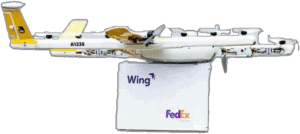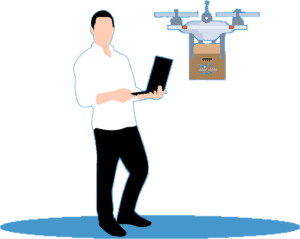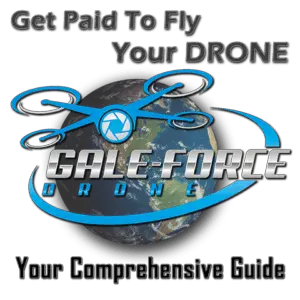
Drone Delivery; the future is now. Drone Delivery is the next big market for your drone startup business to get some market share. This article explains how the market will grow, and what you can do to prepare for it.
Introduction
 From the dawn of humanity until around 1900, people delivered cargo via foot or horseback. Although the first automobile (as we know it) was invented in the 1880’s, it took nearly 20 years for this technology to be professionally applied to the ages-old trade of mail delivery. The first motorized postal vehicle delivered its first package in 1899, with the next two decades seeing massive growth to the point where the U.S. Post Office boasted the largest motorized vehicle fleet by 1920. The first “drones” as we know them began circulating the commercial market in the early 2000’s.
From the dawn of humanity until around 1900, people delivered cargo via foot or horseback. Although the first automobile (as we know it) was invented in the 1880’s, it took nearly 20 years for this technology to be professionally applied to the ages-old trade of mail delivery. The first motorized postal vehicle delivered its first package in 1899, with the next two decades seeing massive growth to the point where the U.S. Post Office boasted the largest motorized vehicle fleet by 1920. The first “drones” as we know them began circulating the commercial market in the early 2000’s.
![]() an American medical product delivery company, founded in 2014 and headquartered in San Francisco California designs, manufactures, and operates delivery drones. Zipline currently operates 4 medical distribution centers in Rwanda and Ghana with plans to begin operations in the U.S. to serve rural areas using the Rwanda as a role model. In 2019, musician Bono joined the board. Zipline is one of the top 3 Drone Services Providers worldwide.
an American medical product delivery company, founded in 2014 and headquartered in San Francisco California designs, manufactures, and operates delivery drones. Zipline currently operates 4 medical distribution centers in Rwanda and Ghana with plans to begin operations in the U.S. to serve rural areas using the Rwanda as a role model. In 2019, musician Bono joined the board. Zipline is one of the top 3 Drone Services Providers worldwide.
 In 2019, FedEx conducted the first commercial drone delivery as part of a pilot program.
In 2019, FedEx conducted the first commercial drone delivery as part of a pilot program.
In the last few years, there have been successful drone delivery services being carried out,
Here in the 2020’s, we stand at the fore of a significant period of expected growth in a very burgeoning Drone Delivery industry. How can we get in on the action, and help the industry to reach its fullest potential?
Drone Delivery Growth Potential
At present day, the global drone delivery market rests at approximately $1B. The majority of this market actually resides outside the United States, where airspace restrictions favor drone operations. But the world’s largest economy continues to adapt, as does the rest of the world.
Professional market studies have estimated the growth of the Drone Delivery market to hit $2.5B by 2023, and $7B by 2026. This is a CAGR (Compound Annual Growth Rate) of nearly 50%. To put this in perspective, here are some estimated CAGRs (5-10 year outlook) from a few other industries for comparison.
- Drone Delivery 50%
- Social Media Analytics 34%
- Healthcare 24%
- Electric Vehicles 22%
- Artificial Intelligence 18%
- Retail 10%
- Real Estate 7%
- Green Energy 6%
- Telecommunications 5%
- Automotive 3%
There are three important aspects to a solid CAGR: (1) there must be a reliable consumer market willing to pay for the product or service; (2) there must be a solid commercial provider base to supply the product or service; and (3) both of these must grow over time.
Let’s think about this for a moment, from the perspective of the Automotive industry. If there was a single company that manufactured automobiles, they could choose how many automobiles to manufacture each year (supply), regardless of the consumer demand. This would be based on how much the company owners were willing to spend to produce their product, prior to the first sale of the year (manufacturing plants, raw materials, workforce labor, etc.). They could also set a high price (probably the highest price that consumers are willing to pay). But, they only need to produce as many automobiles as the company owners require to obtain their desired profit—which may not necessarily reflect the market demand. The net result for the Automotive industry would be a very large slice of a very small pie.
However, since there are multiple manufacturers, each has to only manufacture some percentage of the total consumer demand, and scale their production costs accordingly. They also have to set competitive prices, in a bid to attract customers from their competitors. The total market is larger, since the supply meets or exceeds the market demand. Overall, the market pie is much larger, but each individual company gets a smaller slice. Their challenge is to only produce enough automobiles to satisfy the slice that they intend to take each year.
If the automobile consumer market does not grow, then the CAGR is stagnant near 0%. If the consumer market grows, but the production capacity does not grow, then the CAGR still remains near 0%. Both the supply and demand must grow for the CAGR to rise in percentage.
Based on our Drone Delivery numbers in the list above, both the consumer market and the service provider base are anticipated to increase by an average 50% each year, for the next decade. The pie is getting larger, and the number of companies itching to get a piece of the pie is also growing. The end result is a lot of pie (revenue) for those companies that are well-positioned to provide the services, as long as they can control costs and scale their operations accordingly.
FAA Policy
“I have a Drone with a cargo hook, so I can start doing drone delivery, right?”
Not exactly. At least, not in the United States. And not legally, strictly speaking.
 As of this year, the FAA has more or less established the position that a Part 135 Air Carrier certification is the only current path to drone delivery. Specifically, a Part 135 certification allows an operator to carry the property of another person BVLOS (beyond visual line of sight). Part 135 was designed for legacy aviation (that is, airplanes with humans inside) conducting cargo transportation throughout the country.
As of this year, the FAA has more or less established the position that a Part 135 Air Carrier certification is the only current path to drone delivery. Specifically, a Part 135 certification allows an operator to carry the property of another person BVLOS (beyond visual line of sight). Part 135 was designed for legacy aviation (that is, airplanes with humans inside) conducting cargo transportation throughout the country.
Obtaining a Part 135 is no small feat—the process was designed for manned aircraft, after all. The FAA requires airworthiness certifications, maintenance documentation, operating manuals, training programs, security procedures, etc. It is not for the faint of heart, and requires legitimate effort to maintain this certification year over year.
As of the time of this writing, there are only 3 companies that have obtained a Part 135 with Drone Delivery in mind:
- Wing Aviation (Google subsidiary, partnering with FedEx)
- Flight Forward (UPS subsidiary)
- Prime Air (Amazon subsidiary)
It is rumored that there are around 5 more companies in the certification queue. There are plenty of existing Part 135 carriers who could adopt drones into their operations with relative ease, but the barriers to a pure-drone company obtaining this certification are quite high.
The certification process for a Part 135 includes aircraft airworthiness standards and relief of operating restrictions. Depending on the certification, this can potentially include operations at night, operations over people, and large aircraft (over 55 pounds, including cargo).
Delivery-Worthy Drones
 Today’s commercial delivery drones are operating in very select locations on a trial basis. If you happen to live near these locations, or you want to start preparing your drone startup business for the next evolution of drone delivery, you should consider refining your piloting techniques with a cargo-carrying drone.
Today’s commercial delivery drones are operating in very select locations on a trial basis. If you happen to live near these locations, or you want to start preparing your drone startup business for the next evolution of drone delivery, you should consider refining your piloting techniques with a cargo-carrying drone.
What are some qualities to look for in a cargo drone? First, you’ll want some lift capacity. Packages as small as 0.5 pounds form a large percentage of consumer-level deliveries, so the drone doesn’t have to be huge. Next, it needs to be reliable—this drone will be carrying material that somebody is paying for. Though it should go without saying, the drone will need a cargo hold that can safely release the load at the point of delivery. It should have good navigation capabilities, as the drop sites will be very specific. Finally, it needs to have the power to make the round trip without a battery change.
Click here for an informative article discussing the best drones for industrial services.

The Matrice 600 Pro can be a great entry point into offering Drone Delivery services. The airframe is equipped with the latest DJI technologies, including the A3 Pro flight controller, Lightbridge 2 HD transmission system, Intelligent Batteries and Battery Management system. Several Zenmuse cameras and gimbals are natively compatible and full integration with third party software and hardware make the M600 Pro ideal for professional aerial photography and industrial applications.
In Conclusion
There is no question, the Drone Delivery future is now and the market is poised to explode over the next several years around the world. There are significant policy barriers at the moment in the interest of protecting public safety, but these restrictions will relax over time as the supporting infrastructure develops. If you want to get your drone startup business ready to cash in on this next trend, start working on your drone delivery techniques today while learning about the regulations involved.
How To Get Your FAA Part 107 Pilot Certification
If you are serious about making money with your drone, whether it be Real Estate, Aerial Inspections, etc., then you will need, from the FAA a 14 CFR Part 107 certification.
The best source for your training can be found by clicking on RemotePilot101. Jason Schappert is a pilot and author of 8 best-selling aviation flight training books. While studying and taking tests is not the most fun, Jason breaks it down into 10 easy to follow (at your own pace) video lessons. These lessons are straight and to the point giving you the exact knowledge, nothing less, nothing more than what you need to pass the exam. Additionally, he is continually updating the training to keep it relevant to any changes to FAA regulations. This membership is a 1-time subscription – for life! So when you’re 24 month renewal comes around, just sign in to RemotePilot101 and refresh your training.
Just remember, if you are flying commercially, you will need your Part 107 certification. It’s not hard, you can do it!


